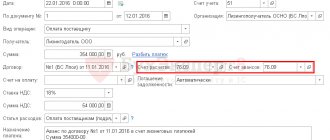Organizations that have vehicles must enter into compulsory civil liability insurance contracts. Additionally, they can enter into voluntary property insurance contracts for motor vehicles. Doctor of Economics, Professor S.A. talks about accounting and tax accounting of individual transactions under compulsory and voluntary insurance contracts in 1C: Accounting 8. Kharitonov.
Enterprises in their economic life can use various vehicles, in particular cars.
After purchasing a car, the organization must first enter into a compulsory civil liability insurance agreement (MTPL), since liability insurance for car owners is mandatory (clauses 1, 2, article 4 of the Federal Law of April 25, 2002 No. 40-FZ “On compulsory civil liability insurance of vehicle owners funds"), and the received MTPL policy is necessary for registering a vehicle with the traffic police, its technical inspection and operation (clause 2 of article 19, clause 3 of article 16 of the Federal Law of December 10, 1995 No. 196-FZ “On Road Traffic Safety” ; clauses 1, 3 of Article 32 of the Federal Law of April 25, 2002 No. 40-FZ).
Payments under compulsory motor liability insurance may not fully cover the damage that may be caused to a car during an accident (traffic accident). In addition, only the injured party is compensated for losses. Therefore, organizations, in addition to compulsory motor liability insurance, enter into voluntary property insurance contracts for the vehicle itself against theft and possible damage as a result of an accident, illegal actions of third parties and damage due to other risks. In auto insurance practice, such contracts are called CASCO contracts (from the Spanish casco - “hull”, “hull”).
OSAGO and CASCO agreements are usually concluded for one year and come into force from the moment the policy is paid for. In accounting, the costs of purchasing MTPL and CASCO policies are recognized as expenses for ordinary activities (clause 5 of PBU 10/99).
At the same time, according to the interpretation of P112 “On the participation of an organization in insurance contracts as an insured”, adopted by the Accounting Development Fund “National non-state accounting regulator “Accounting Methodological Center”” (see https://bmcenter.ru/Files/P112), the purchase of a policy does not result in the occurrence of future expenses in the accounting records of the insured organization.
Payment for the policy by the policyholder is accounted for as an advance payment for services (advances for services), which is recognized as an expense of the organization as insurance services are consumed, i.e., as the insurance period expires. The specified prepayment is reflected in the account for settlements with insurers. Before the expiration of the paid insurance period, the corresponding amounts are reflected in the balance sheet depending on their materiality under an independent item or are included in the aggregate item “Other current assets” or “Other non-current assets” (if paid for a period of more than a year).
To account for settlements with insurers for prepayment amounts in the interpretation of P112, it is recommended to use account 76 “Settlements with various debtors and creditors” subaccount 76-1 “Settlements for property and personal insurance”.
In tax accounting, the cost of an MTPL policy is taken into account when taxing profits within the limits of insurance tariffs (Clause 1, Article 263 of the Tax Code of the Russian Federation).
Costs for CASCO insurance are recognized when taxing profits in the amount of actual costs (subclause 1, clause 1, clause 3, article 263 of the Tax Code of the Russian Federation).
At the same time, insurance premiums under MTPL and CASCO contracts are recognized evenly during the term of the contract - in proportion to the number of calendar days in the reporting period (clause 6 of Article 262 of the Tax Code of the Russian Federation). The costs of paying premiums are included in other expenses associated with production and (or) sales (clauses 2 and 3 of Article 263 of the Tax Code of the Russian Federation).
To account for prepayment amounts under MTPL and CASCO contracts in 1C: Accounting 8, subaccount 76.01.9 “Payments (contributions) for other types of insurance” is intended. Analytical accounting for Subconto 2 in subaccount 76.01.9 is carried out according to items of expenses of future periods, which allows automatic write-off of the amounts recorded in this subaccount according to certain rules, in particular, evenly - in proportion to the number of calendar days in the reporting period.
We will consider the procedure for accounting for the costs of purchasing MTPL and CASCO policies in 1C: Accounting 8 using the following example.
Example1
| In connection with the purchase of a car, the organization insured its civil liability on October 1, 2012, and also issued a CASCO agreement. The cost of the MTPL policy was 6,000 rubles, CASCO - 60,000 rubles. The amount of insurance premiums for compulsory motor liability insurance was transferred on October 1, 2012. The CASCO agreement provides for payment of the insurance premium in two stages: until October 2, 2012 and until April 1, 2013. Payment of contributions for the first 6 months was made on October 1, 2012. The insurance period under MTPL and CASCO contracts is from October 1, 2012 to September 30, 2013. |
Let's consider the reflection of these events in the organization's accounting.
1) The transfer of the insurance premium is reflected in the documents Write-off from the current account for the type of transaction Other write-off:
from 01.10.2012 - for the amount of insurance premiums under compulsory motor liability insurance and the first payment under the CASCO agreement;
dated March 30, 2013 - for the amount of the second payment under the CASCO agreement.
In the Payment Decoding section of the document Write-off from the current account form, the following is indicated:
- debit account 76.01.9 “Payments (contributions) for other types of insurance”;
- analytics for the subconto Counterparties and Deferred Expenses.
The description of the deferred items in the reference book Deferred Expenses indicates (Fig. 1):
- Type of RBP - Other;
- Method of recognizing expenses - By calendar days;
- Amount - the amount of the transferred insurance premium;
- Start of write-off and End of write-off - paid insurance period;
- Account and Subconto - account and analytics to which insurance premiums are written off;
- Type of asset - “Other current assets”.
Rice. 1
2) The monthly inclusion of paid insurance premiums in the expenses of the current period in terms of the insurer’s services consumed is carried out when performing the routine operation of closing the month Write-off of future expenses.
To document the amounts included in expenses, it is recommended to create and print out on paper a Statement of Calculation for the transaction (Fig. 2), compiled separately “according to accounting data” and “according to tax accounting data.”
Rice. 2
Insurance premium and types of insurance
The insurance premium is a fee for insurance (Article 954 of the Civil Code of the Russian Federation), which the policyholder (a legal entity or individual who decides to insure life, health, property, liability or risks) pays to the insurer (a legal entity authorized to conduct insurance activities) upon concluding an agreement insurance.
Insurance occurs in relation to the occurrence of any specific cases, can be carried out both in the interests of the policyholder himself and in favor of third parties and can be either mandatory (provided for by one of the laws of the Russian Federation) or voluntary.
The amount of the insurance premium is indicated in the insurance contract and is determined according to the tariffs developed by the insurer itself or the insurance supervisory authorities.
There are many types of insurance:
- personal - related to life and health;
- property, designed to reduce losses from loss, shortage or damage to any property;
- various types of risks - such as, for example, technical, financial (including those associated with non-receipt of payment from buyers or goods from suppliers), legal;
- liability - for example, civil, professional, developer, borrower.
If you do not know how to reflect the insurance premium under the MTPL agreement, use the recommendations from ConsultantPlus. Get trial access to the system and move on to the Ready-made solution. It's free.
Accounting for liability insurance
Liability insurance involves compensation for damage caused by the insurer to a third party. For example, a person received insurance in case of apartment flooding. And then he flooded his neighbor's apartment. In this case, the insurance company compensates for the damage caused to this neighbor. Let's look at other common cases of liability insurance:
- Damage caused to someone else's vehicle during its operation.
- Damage caused to the environment or people due to potentially hazardous activities.
- Damage caused to third parties in connection with the performance of legal or medical activities.
Let's look at the entries made for liability insurance (example):
- DT22/1 KT51. Payment of damages to a person injured in a car accident.
- DT91/2 KT22/1. The payment is included in the spending structure.
- DT50 KT91/1. Receipt of money from a person found guilty of an accident.
FOR YOUR INFORMATION! You can insure business risks. In this case, the insurance agreement ends early upon termination of business activity.
Payers of premiums under an insurance contract
The insurance premium is paid by the person who entered into an agreement with the insurer. This person may be:
- employer - in relation to contracts of compulsory or voluntary personal insurance of employees;
- owner of property or a person disposing of it with the right of operational management (economic management);
- the person responsible for the safety of the property, including the tenant or carrier;
- a person who may face risks of certain losses due to circumstances beyond his control;
- a person who, due to his actions or, conversely, inaction, can cause damage to third parties.
In relation to the same item, insurance contracts with different insured parties may be in place at the same time: for example, the seller who dispatches it to the buyer and the carrier who carries out the actual delivery can insure property liability in relation to the same consignment of goods.
Property actually used under a lease agreement may be insured:
- Voluntarily: for example, by the tenant or landlord of the property. It is advisable to include a clause about who will insure the property in the text of the lease agreement. This will be important, for example, for payers of the simplified tax system working with the object “income minus expenses”, who will not be able to take into account the costs of voluntary insurance in expenses when calculating the single tax (subclause 7, paragraph 1, article 346.16 of the Tax Code of the Russian Federation, letter from the Ministry of Finance of the Russian Federation dated May 20, 2009 No. 03-11-09/179).
- Mandatory: for example, in relation to rented (leasing) vehicles, when the transport is registered in the name of the lessee (lessee) for the duration of the contract. The presence of an MTPL policy issued for this vehicle by the insured is mandatory when registering the vehicle with the State Traffic Safety Inspectorate.
Answers to common questions about company property insurance
Question No. 1: Are there any plans in the near future to expand the list of cases in which it is necessary to conclude compulsory insurance contracts?
Answer: Yes, the Russian Government is considering options such as compulsory insurance or issuing a financial guarantee in case of information leakage. In addition, the possibility of insuring workers against job loss is being discussed.
Question No. 2: Is it possible to estimate the costs of paying insurance contributions for compulsory pension insurance, social insurance in case of temporary disability and in connection with maternity in relation to Article 263 of the Tax Code of the Russian Federation?
Answer: This makes no sense, since the costs you mentioned are already taken into account in order to reduce the tax base for income tax on an independent basis. See Letter of the Ministry of Finance of the Russian Federation dated June 14, 2016 No. 03-03-06/1/34409, sub. 1, 45 p. 1 art. 264 Tax Code of the Russian Federation.
Question No. 3: What to do if tariffs for compulsory insurance are not approved?
Answer: In this case, compulsory insurance costs should be included in expenses in the amount of actual costs incurred.
Payment of insurance premium and its return by the insurer
The effective date of the insurance contract may be indicated in the contract itself. If it is not there, the contract will come into force from the date of payment of the insurance premium (clause 1 of Article 957 of the Civil Code of the Russian Federation). It is allowed that the insurance premium can be paid in installments, but the start date of the contract, if there is no indication of it in the text of this document, will coincide with the day of the first payment.
Thus, payment of the premium in relation to the date of entry into force of the contract can be made:
- on this date;
- before this date;
- after this date.
For late payment of the next installment, the contract may provide for penalties. If the next part of the payment is not paid, the insurance contract will terminate upon the expiration of the period corresponding to the amount of the insurance premium actually paid.
Before the expiration of the contract, situations of its early termination may arise related to the loss of property or termination of activities by the insured (clause 1 of Article 958 of the Civil Code of the Russian Federation). In this case, the insurer must return to the policyholder that part of the insurance premium that corresponds to the period of unclaimed insurance contract. A similar condition for the return of the premium may be provided for in the contract for the situation of the policyholder’s voluntary refusal of this document.
How to reflect in accounting the return of the insurance premium in case of early termination of the CASCO agreement, ConsultantPlus experts told. If you don't have access to the system, get a free trial online.
For more information about when the insurer returns the premium, read the article “Insurance premium is...”.
Documents for an accountant keeping records of logistics operations
There are two types of documents that an accountant keeping records of logistics activities must be familiar with: general and private. The list of general ones includes the second part of the tax code, and the provision “Accounting for inventories” of PBU 5/01 of 2001, and methodological instructions. Private documents come into play when specific transactions need to be carried out. Thus, when delivering cargo by a transport company, accounting is kept on the basis of the following documents:
- Federal Law “On transport and forwarding activities” No. 87-FZ dated June 30, 2003;
- rules of transport and forwarding activities approved by Decree of the Government of the Russian Federation of September 8, 2006 No. 554;
- Civil Code of the Russian Federation, in particular Chapter 41 “Transport expedition”;
- Order of the Ministry of Transport dated February 11, 2008 No. 23 “On approval of the Procedure for registration and forms of forwarding documents.”
If we are talking about forwarding, it is also important to obtain documents on the basis of which a specific operation will be carried out. They include an order to the forwarder, forwarding and warehouse receipts, as well as a transport expedition agreement, which specifies the role of the transport company: intermediary or service provider.
Insurance premium settlement account
To account for settlements under contracts of all types of insurance in which a legal entity acts as an insured (except for mandatory social, pension and medical, accounted for in account 69), the chart of accounts (Order of the Ministry of Finance of the Russian Federation dated October 31, 2000 No. 94n) provides a separate subaccount for account 76: 76 -1 “Calculations for property and personal insurance.”
Analytics on this sub-account is organized in relation to each insurer and each contract concluded with this insurer.
Payment of the insurance premium under the insurance contract will be reflected in the accounting entry as follows: Dt 76-1 Kt 51 (51, 71).
The posting will be reversed when returning part of the premium under an early terminated contract: Dt 51 (50) Kt 76-1.
VAT will not appear in the calculations, since insurance services are exempt from this tax (subclause 7, clause 3, article 149 of the Tax Code of the Russian Federation).
Accounting for insurance costs in accounting will begin from the day the insurance contract comes into force. The procedure for accounting for insurance costs is not regulated by accounting legislation. Therefore, they can be expensed either at a time or over the life of the contract. PBU 10/99 allows you to do both (Order of the Ministry of Finance of the Russian Federation dated May 6, 1999 No. 33n). The decision about this should be written down in the accounting policy. However, in any case, only the amount of the insurance premium that will actually be paid can be included in the costs. Therefore, if the premium is paid in installments and the accounting policy involves writing it off as expenses during the term of the contract, the paid amount will need to be distributed not over the entire term of the contract, but only for the period that was actually paid.
In the credit part of the entry for the insurance premium, reflecting its acceptance for accounting, in any case, subaccount 76-1 will be indicated. In the case of a one-time write-off, the debit part will indicate cost (or other expenses) accounts. But for the method of debiting during the period, the account numbers of the debit part of this entry may have options. In addition, with each write-off method (at a time or for a period), there will be differences between the accounting (BU) and tax (TA) accounting data, depending on the discrepancy:
- methods of attribution to expenses acceptable for accounting and financial accounting;
- amounts that can be taken into account in expenses according to the rules of accounting and accounting;
- moments of accounting in expenses according to the requirements of accounting and accounting regulations.
The discrepancies between the BU and NU rules for insurance expenses are as follows:
- The accounting system allows for their write-off both at one time and over a period. In NU, a one-time write-off is possible only for an agreement valid within one reporting period for income tax, and a longer period of validity requires mandatory distribution of expenses (clause 6 of Article 272 of the Tax Code of the Russian Federation).
- In accounting, expenses are always recognized in their full amount, and for acceptance into the NU the following restrictions apply: within the limits of legally established tariffs for compulsory property insurance (clause 2 of article 263 of the Tax Code of the Russian Federation);
- no more than 15,000 rubles. per year per employee under voluntary personal life or health insurance contracts concluded for a period of at least a year (clause 16 of Article 255 of the Tax Code of the Russian Federation);
- no more than 12% of the wage fund for long-term (more than 5 years) life insurance contracts (clause 16 of Article 255 of the Tax Code of the Russian Federation);
- no more than 6% of the wage fund under voluntary health insurance contracts concluded for a period of at least a year (clause 16 of Article 255 of the Tax Code of the Russian Federation).
The emergence of differences between accounting accounting and NU for a number of taxpayers entails the obligation to apply PBU 18/02. To whom exactly does this apply, read the material “PBU 18/02 - who should apply and who should not?” .
Accounting for expenses and compensation in case of theft (theft) of a car
If the car was insured against theft (theft), then in the event of an insured event, the insurance company must pay the organization insurance compensation in the amount established by the CASCO agreement, but not exceeding the actual (insurable) value of the property (Article 947 of the Tax Code of the Russian Federation).
Insurance compensation in accounting is recognized as other income (clause 7 of PBU 9/99), and for profit tax purposes it is taken into account as non-operating income (clause 3 of Article 250 of the Tax Code of the Russian Federation). The date of its receipt is considered to be the date of recognition by the insurance company of the amount of compensation for damage (subclause 4, clause 1, article 271 of the Tax Code of the Russian Federation).
In “1C: Accounting 8”, calculations for insurance compensation in case of theft (theft) of a car are reflected in the same way as the above-discussed accounting for calculations for funds for car repairs after an accident (see Example 2).
A stolen (stolen) car is subject to write-off from accounting (clause 29 of PBU 6/01), as in the case of an accident, on the basis of a vehicle write-off act. This can be done in the reporting period when the theft occurred based on the inventory, as well as a copy of the resolution to initiate a criminal case. In this case, the residual value, as in the case of an accident, is included in the other expenses of the organization.
For profit tax purposes, the residual value of a stolen (stolen) car is recognized as non-operating expenses, but provided that it was not possible to identify the culprit (subclause 5, clause 2, article 265 of the Tax Code of the Russian Federation).
Thus, the residual value of the car is taken into account as part of the expenses of the reporting (tax) period in which a decision was made to suspend the criminal case on the fact of theft (theft).
To bring accounting and tax accounting closer together, it is recommended to reflect the residual value of the car before assigning it to other expenses as a shortage on account 94 “Losses and shortages from damage to valuables” and, after the suspension of the criminal case, write off as a debit to account 91.02 “Other expenses”.
We will consider writing off a stolen (stolen) car from the register and recognizing expenses in 1C: Accounting 8 using an example.
Example 4
| The organization owns a car used for management purposes: — 05.11.2012 — theft of a car was committed; — On November 12, 2012, a copy of the resolution to initiate a criminal case on the fact of theft was received. On the same day, based on the results of the inventory, a decision was made to write off the car from the register. The residual value of the car in accounting and tax accounting, taking into account depreciation for November 2012, is 190,950.00 rubles; — 12/20/2012 — a copy of the decision to suspend the criminal case on the fact of theft and a positive decision of the insurance company on payment of insurance compensation was received. |
Let's consider the reflection of these events in the organization's accounting.
1) The deregistration of a vehicle based on the results of the inventory is reflected using the document Write-off of fixed assets. The form of the document indicates Expense Account - 94 “Shortages and losses from damage to valuables”, Reason - “Theft (theft)”.
2) The write-off of the residual value of account 94 to account 91.02 “Other expenses” is reflected in the document Operation (accounting and tax accounting) (Fig. 6). In the transaction debit analytics, the item of other income and expenses is indicated with the type Income (expenses) associated with the liquidation of fixed assets and a fixed asset item written off from accounting.
Rice. 6
Accounting for insurance premiums at a time
Accounting rules (clauses 16–18 of PBU 10/99) allow for the possibility of one-time recognition of insurance expenses on the date the insurance contract comes into force. Logically, this is explained by the fact that at this moment the insurer should not have any debt to the policyholder: the insurance premium is payment for concluding an insurance contract, and since the contract is concluded, the insurer’s obligations as of the date of its conclusion are fulfilled.
The accounting entry here will be like this: Dt 20 (23, 25, 26, 44, 91) Kt 76-1.
Tax consequences:
- If the agreement is short-term (no more than one reporting period for income tax), the entire agreement falls within this reporting period, the beginning of the agreement according to the rules of both accounting falls on the same period, there are no discrepancies in the amount of amounts accepted for accounting, then the differences between the accounting accounting data and NU will not arise.
- Discrepancies in accounting and accounting records will appear if one of the following points occurs: the contract period extends beyond one reporting period and for accounting accounting, accordingly, costs must be accounted for over more than one period;
- for NU, restrictions are triggered for acceptance into costs;
- do not coincide and fall on different reporting periods, the start date of the insurance contract for BU and NU.
A discrepancy between the accounting rules in accounting and national accounting can lead to both the formation of expenses that are not accepted for the purposes of calculating income tax, and to discrepancies in the timing of accounting for these expenses. In the latter case, there is usually an entry for deferred tax assets: Dt 09 Kt 68, corresponding to the earlier recognition of insurance expenses in accounting expenses. As the amounts are accepted into the NU, these differences will be leveled out, and the tax on them will be written off: Dt 68 Kt 09.
Posting Dt 68 Kt 77 is less common, but can also occur if in the NU the agreement begins to be valid earlier than in the BU. Smoothing out the differences between accounts in this case will be reflected by posting Dt 77 Kt 68.
Thus, the one-time recognition of expenses in accounting for most insurance contracts will lead to the formation of differences between accounting and accounting.
Features of creating insurance reserves
The formation of insurance reserves is an event considered mandatory for an insurance company. The mandatory creation of such reserves is stipulated in Article 26 of Federal Law No. 4015-1 “On the Insurance Business” of November 27, 1992. The sequence of formation of reserves is specified in the order of the Ministry of Finance No. 51 n dated June 11, 2002.
Let's consider the sequence of formation of reserves:
- Establishing the required type of reserve. Orders of the Ministry of Finance 32n and 51n will help with this. You also need to focus on the local regulations of the company.
- Establishing a method for determining the reserve.
- Determination of the reserve for each insurance agreement.
The reserve is needed to ensure that the organization always has the amount of funds that is needed in the event of an insured event.
Accounting for insurance premiums during the term of the contract
The use of the second method, which allows for the use in accounting of expenses to be written off by justifying their distribution between reporting periods, helps to smooth out the differences that arise between accounting periods and accounting periods (clause 19 of PBU 10/99). This method can be used in two ways:
- The paid premium is regarded as a receivable (which is allowed by clause 16 of PBU 10/99, and an additional motive is the possibility of returning part of the premium upon early termination of the insurance contract) and is included in expenses as insurance services are recognized as completed. That is, every month the part of the premium due for this month is written off directly from subaccount 76-1 to expenses: Dt 20 (23, 25, 26, 44, 91) Kt 76-1.
- The part of the premium not included in expenses in the reporting period in which the contract begins is considered deferred expenses. This allows you to do this in clause 65 of the PBU on accounting and accounting (order of the Ministry of Finance of the Russian Federation dated July 29, 1998 No. 34n) and clarifications of the Ministry of Finance of the Russian Federation (letter dated January 12, 2012 No. 07-02-06/5). That is, in the month the contract begins, the part of the premium attributable to this month will be written off as expenses: Dt 20 (23, 25, 26, 44, 91) Kt 76-1, and the remainder will be taken into account as deferred expenses: Dt 97 Kt 76-1. In the future, the amount of insurance expenses corresponding to this month will be written off monthly as expenses using the entry Dt 20 (23, 25, 26, 44, 91) Kt 97.
For the majority of insurance contracts, the use of any of the two indicated methods will lead to the absence of differences between their accounting in accounting and accounting records. Discrepancies may arise if:
- for NU, restrictions are triggered to be accepted into costs - in this case, both temporary differences and permanent ones may arise;
- do not coincide and fall on different reporting periods, the start dates of the insurance contract for BU and NU - this leads to the formation of temporary differences that disappear upon completion of the contract. One example of such differences is the issuance of monthly insurance contracts for the volume of cargo actually shipped per month, with invoicing and payment in the month following the month of dispatch. Here, in the accounting system, the expense is recognized earlier than in the tax accounting system, and for months located on the border of the reporting periods for income tax, the difference must be taken into account when calculating this tax:
- Dt 09 Kt 68 - in the month of shipment;
- Dt 68 Kt 09 - in the month of payment of the insurance premium.
How expenses on insurance policies are recognized
The amounts paid are reflected in the organization’s expenses using the “Month Closing” processing located in the “Operations” section.
After documents for the month have been posted and the period has been closed, you can see the result of writing off expenses for future periods. To do this, click on the name and select the “Show transactions” menu.
The following figure shows the correspondence of accounts.
The details of the calculation can be found by displaying the calculation help on the screen. You must click “Write off future periods” again and select the second line with the report icon from the drop-down menu. Settings in the report can be changed depending on the required indicators.
Features of accounting for payments in SRO
Considering the features of accounting for insurance premiums, it is logical to mention payments to the SRO (self-regulatory organization), membership in which for a number of taxpayers is a mandatory condition for carrying out their activities.
The obligatory nature of contributions to the SRO necessitates their one-time accounting in the NU on the date of payment. And for accounting, as well as for insurance premiums, there are 2 options for attributing to costs:
- One time.
- During the period that the taxpayer sets independently, since the SRO certificate is unlimited. Usually this period is set to 3–5 years.
The methods of writing off in accounting entries for these options will be exactly the same as when accounting for insurance premiums: directly to cost accounts from account 76 or through account 97.
However, for the purpose of bringing accounting accounting and financial accounting closer together, it is better to make a decision on one-time accounting in accounting. Writing off during the accounting period can be justified only in case of large amounts of payments, which, if charged at a time as expenses, will significantly worsen the accounting indicators. If there is a discrepancy in the methods of accounting for payments in the SRO, temporary differences will appear, the tax from which will be taken into account in account 77, since in the NU expenses are recognized earlier: Dt 68 Kt 77.
The write-off of tax differences will be reflected as expenses are taken into account in the accounting system by postings Dt 77 Kt 68.
OSAGO policies
Obtaining an MTPL policy after purchasing a vehicle is a prerequisite for any enterprise. Otherwise, it is impossible to register the car with the traffic police. It is required to obtain a policy on the basis of Article 4 of Federal Law No. 40-FZ of April 25, 2002 “On compulsory insurance of civil liability of vehicle owners.”
Unlike the mandatory MTPL policy, the CASCO policy is voluntary. Considering that the use of compulsory motor liability insurance does not allow repaying the entire cost of the damage caused and payments are made only to the injured party, many organizations prefer voluntary property insurance.
You can track mutual settlements with the insurance company on account 76.01.9 “Payments (contributions) for other types of insurance.” Typically, vehicle insurance is issued for 1 year, but expenses according to accounting and tax accounting are accepted monthly (as RBP).
Let's see how operations for accounting for auto insurance contracts are carried out in 1C Accounting 8. For example, an organization has entered into two insurance contracts: compulsory motor liability insurance in the amount of 5 thousand rubles and CASCO in the amount of 50 thousand rubles.
Results
Reflection of insurance premiums in accounting has its own characteristics, determined both by the very essence of these payments and by the availability of the possibility of using different options for recording them in accounting: at a time or during the period of validity of the contract. The choice between accounting options allows you to minimize discrepancies in insurance premiums in accounting and accounting records. The decision made must be formalized in the accounting policies.
Sources:
- Tax Code of the Russian Federation
- Order of the Ministry of Finance of the Russian Federation dated October 31, 2000 N 94n
- PBU 10/99, approved. by order of the Ministry of Finance of Russia dated May 6, 1999 N 33n
- Order of the Ministry of Finance of Russia dated July 29, 1998 N 34n
You can find more complete information on the topic in ConsultantPlus. Free trial access to the system for 2 days.
Step-by-step instruction
On April 2, a Ford Mondeo was purchased.
On April 3, the car was insured by PJSC IC Rosgosstrakh: an insurance premium of MTPL was paid in the amount of 14,820 rubles. for the period from April 4 of the current year to April 3 of the next year
Let's look at step-by-step instructions for creating an example. PDF
| date | Debit | Credit | Accounting amount | Amount NU | the name of the operation | Documents (reports) in 1C | |
| Dt | CT | ||||||
| Payment of insurance premium | |||||||
| April 03 | 76.01.9 | 51 | 14 820 | 14 820 | Payment of MTPL insurance premium | Write-off from current account - Other write-off | |
| 013 | 14 820 | Accounting for MTPL insurance policy | Manual entry - Operation | ||||
| Reflection in accounting for insurance premium costs for April | |||||||
| April 30 | 26 | 76.01.9 | 1 096,27 | 1 096,27 | 1 096,27 | Accounting for compulsory motor liability insurance costs | Closing the month - Write-off of deferred expenses |
| Reflection in accounting for insurance premium costs for May | |||||||
| May 31 | 26 | 76.01.9 | 1 258,69 | 1 258,69 | 1 258,69 | Accounting for compulsory motor liability insurance costs | Closing the month - Write-off of deferred expenses |
For the beginning of the example, see the publication:
- Purchasing OS (auto)










